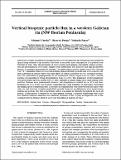Por favor, use este identificador para citar o enlazar a este item:
http://hdl.handle.net/10261/25129COMPARTIR / EXPORTAR:
 SHARE SHARE
 CORE
BASE CORE
BASE
|
|
| Visualizar otros formatos: MARC | Dublin Core | RDF | ORE | MODS | METS | DIDL | DATACITE | |

| Título: | Vertical biogenic particle flux in a western Galician ria (NW Iberian Peninsula) |
Autor: | Varela, Manuel; Prego, R. CSIC ORCID ; Pazos, Yolanda | Palabras clave: | Particle flux Carbon Chlorophyll Phytoplankton Galicia Pontevedra Ría |
Fecha de publicación: | 25-mar-2004 | Editor: | Inter Research | Citación: | Marine Ecology Progress Series 269: 17-32 (2004) | Resumen: | Fluxes of particulate pelagic material were measured in the Pontevedra Ría (northwest Spain) using sediment traps moored at the base of the photic zone, deployed for 24 h periods from February to June 1998. Measurements of water column hydrography, chlorophyll, primary production and phytoplankton were taken. Samples were divided into low, moderate and high productivity periods, according to phytoplankton biomass. The vertical flux of carbon ranged from 530 to 1780 mg C m–2 d–1. Minimum values were recorded during high productivity periods, and were related to offshore advection of surface water. The daily export of carbon accounted for 75% of primary production. The contribution of phytoplankton to the sedimented carbon ranged from 18 to 66%, and the fraction corresponding to living phytoplankton from 5 to 25%. The dominance of phytoplanktonic over phytobenthic species, and the low C:N ratio, indicated a pelagic origin and a rapid sinking of the particles. Diatoms were predominant; however, microflagellates accounted for ca. 20% and dinoflagellates for 13% of the total biomass, suggesting the rapid formation of aggregates, increasing the sinking speed of individual cells. A decrease in sedimentation was observed from the inner to the outer ria, and from low to higher productivity periods. However, no differences were found among stations and periods. The flux of particulate carbon was similar in intensity throughout the ria in all periods. Sedimentation is influenced by hydrography, showing a negative relationship with water flux. Balance between advection and retention processes in the ria play an important role in the coupling between biomass stock in water and deposition of material in traps. | Descripción: | 16 pages, 6 figures, 5 tables. | Versión del editor: | http://dx.doi.org/10.3354/meps269017 | URI: | http://hdl.handle.net/10261/25129 | DOI: | 10.3354/meps269017 | ISSN: | 0171-8630 |
| Aparece en las colecciones: | (IIM) Artículos |
Ficheros en este ítem:
| Fichero | Descripción | Tamaño | Formato | |
|---|---|---|---|---|
| m269p017.pdf | 260,12 kB | Adobe PDF |  Visualizar/Abrir |
CORE Recommender
SCOPUSTM
Citations
36
checked on 24-abr-2024
WEB OF SCIENCETM
Citations
38
checked on 13-feb-2024
Page view(s)
365
checked on 05-may-2024
Download(s)
261
checked on 05-may-2024
Google ScholarTM
Check
Altmetric
Altmetric
NOTA: Los ítems de Digital.CSIC están protegidos por copyright, con todos los derechos reservados, a menos que se indique lo contrario.
